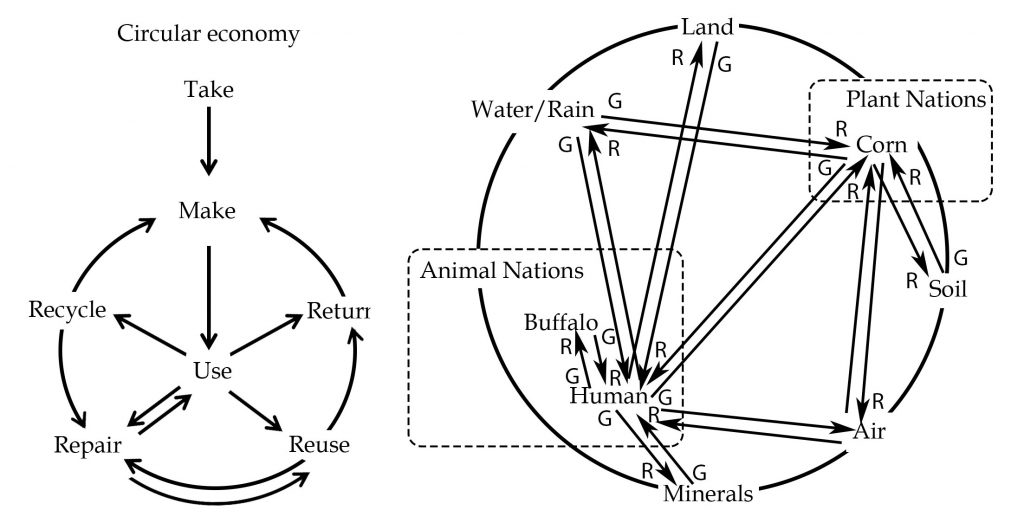NOTE: This page will not make much sense unless you do this page that introduces Circular and Linear Economies FIRST. I strongly suggest you then read the page on Redrawing a Linear Economy as the second page in the sequence, and only read this page as the third and last of that series.
Here is how I redrew the circular economy diagram from the original illustration whose paradigm we’re evaluating. There are even more ways to redraw this one than the linear economy diagram, so yours may look very different. That’s all right. The thing to pay attention to is which paradigm is expressed. I explain the choices I made when I drew mine in the text beneath the picture.

I made the circle of my diagram big enough to include the Land that’s still got to be on the original diagram’s “Take” end, and I omitted the typical “green” recycle-reuse-reduce verbs because that whole part of the diagram is only human-to-human. So it would all be in a little tiny circle where you see the word “Human” on the redrawn figure. I think it’s interesting to see how focusing on that recycle-reuse-reduce part of things in the original figure makes the economy very human-centric. The rest of the world vanishes.
Yet the point of the exercise, because it was the point of the original UN paper according to its own foreword text, is “to redesign a path to progress that respects the intertwined fate of people and planet.” So the planet needs to be here, not just people and their human-to-human interactions. A diagram that reduces the entire gigantic circle of the redrawn “circular economy” diagram to a single word — “Take” — is a diagram that tells anyone who looks at it that humans are completely separated from the planet and all of nature. And in fact, however unintentional that may have been, the original diagrams depict economies as literally free-floating human activities so profoundly separated from nature that the “human-nature relationship” is one of total estrangement.
The redrawn circular economy diagram may remind you of one of the Nitrogen Cycle or Water Cycle. Interestingly, even though the original circular economy diagram image included only humans handing off presumptive clothing and furniture to one another in the reuse-recycle part, whoever wrote the text remembered there had to be more to an ecology-grounded economy than this. Cycling of Nitrogen, Phosphorus and Potassium through “food systems” is very briefly mentioned in the passage that immediately follows Fig. 3.11 in the original UN Human Development Report. But almost immediately, the text shifts back to a typically “green” position that addresses recycling in terms of manufactured items such as electronics. That little peek-through moment of the Nitrogen cycle in the written text is very important though. It shows that awareness of the ontologically real human-nature connection that exists between economic systems and the movements of material and energy through the world’s ecosystems was there.
The question, then, is: Why wasn’t this perception more clearly developed in the report? How did this figure end up depicting the old paradigm the report wanted to overturn? What we’re seeing here is part of a larger pattern of a conflict within Western culture itself right now. People are increasingly voicing a desperate desire to forge a new and healthier relationship with nature, then falling back into an old pattern of separation from nature — without consciously seeing they’ve done it. Something is blocking the change people want to make in their lives, and it’s operating at such a deep level that it has to be subconscious. In Western culture, the pedagogy of the subconscious is Story.
Click here to go back to the page with the original diagrams and questions.
Click here to look at my redrawn linear economy diagram again.
